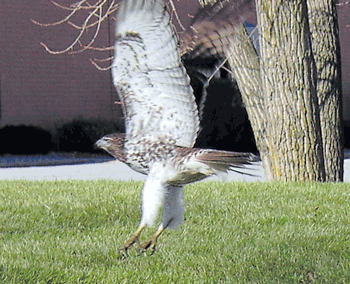FALL IS HERE
 The sky is clear and blue, this morning, an example of October’s bright blue weather. Today is a few minutes shorter than yesterday and tomorrow be a few minutes shorter than today. Tree leaves are changing from green to yellow and orange and red. Corn stalks in the fields are yellow-green and soybeans are turning yellow. Goldenrod is in bloom, decorating country roadsides, pastures and hay fields with splashes of yellow. It’s fall. The evidence is in the sky, the leaves on the trees, the crops in the fields, the wildflowers.
The sky is clear and blue, this morning, an example of October’s bright blue weather. Today is a few minutes shorter than yesterday and tomorrow be a few minutes shorter than today. Tree leaves are changing from green to yellow and orange and red. Corn stalks in the fields are yellow-green and soybeans are turning yellow. Goldenrod is in bloom, decorating country roadsides, pastures and hay fields with splashes of yellow. It’s fall. The evidence is in the sky, the leaves on the trees, the crops in the fields, the wildflowers.
Birds also provide evidence of the season. The birds at my bird feeders are the same species that have been coming all summer, mourning doves and house sparrows, cardinals and blue jays, white-breasted nuthatches, black-capped chickadees, downy woodpeckers, tufted titmice. But many of them look more dull colored than they did last spring and summer. Those dull colored birds are young, birds that were hatched and grew this year, immatures. Any day now I expect to see other birds at my feeders, fall arrivals, white-throated or white-crowned sparrows, tree sparrows, a red-breasted nuthatch.
In spring I like to walk in the woods, look up in the trees, search for warblers and vireos and other little birds. Some of those little colored travelers will stay to nest in the woods near my home but many will continue on and nest farther north. In fall birds are not as numerous in woods and then I like to drive in the country and look for migrating birds, particularly flocks of migrants.
There was a time, many years ago, when red-winged blackbirds were the most numerous birds I saw drifting about the countryside. Often a flock would settle and feed in a cornfield. At dusk the flocks of redwings gather together and roost in the cattails of a marsh. Times have changed. Now I see more starlings than redwings.
Recently my younger daughter called and told me she had seen a flock of hawks that morning, circling together and drifting across the sky. “There must have been fifty of them,” she said. They looked like red-tailed hawks but were smaller and had bands on their tails she told me.
“A kettle of hawks,” I exclaimed, “broad-winged hawks.” These crow-size buteos nest farther north, gather and wing their way south in fall. They’re forest birds and at night they roost in trees. I watched a kettle of broad-winged hawks circling and dropping into a woodlot near the campus of Iowa State University at dusk once. I watched until the last hawk had disappeared into the trees and I was back at dawn the next morning. Skipping my morning classes I watched the hawks emerge from the trees, staying until every hawk was out of the trees and in the air, circling and drifting away.
Rough-legged hawks fly all the way to the Gulf Coast. A few stop there and stay in Florida for the winter but most cross the Gulf of Mexico and spend the winter in South America.
Driving past lakes and marshes in fall, and in spring, there’s always the possibility of seeing flocks of waterfowl or shorebirds. As the fall passes I’ll by out looking for winter wanderers, birds that travel erratically, unpredictably in fall and in winter. Short-eared owls are an example. I’ve seen flocks of short-ears, during the day, flying low over grassy fields, perching on fence posts and power poles.
I’ll see flocks of dark-eyed juncos any day now, along country roads and on and around my bird feeders. I’ll see horned larks along country roads. And all the time I’m out, looking for birds I can enjoy the fall color and on sunny days, October’s bright blue weather.
- Birds As Weather Forecasters – Life In The Outdoors - December 17, 2021
- Rare Bird Spotted In Indiana – Life In The Outdoors - October 8, 2021
- MY EXPERIENCE WITH DEER – Life In The Outdoors - July 30, 2021


